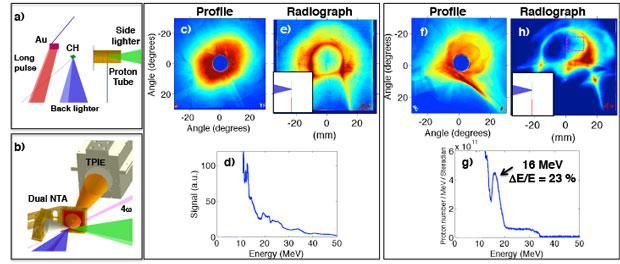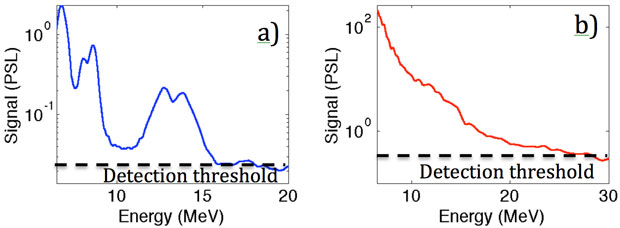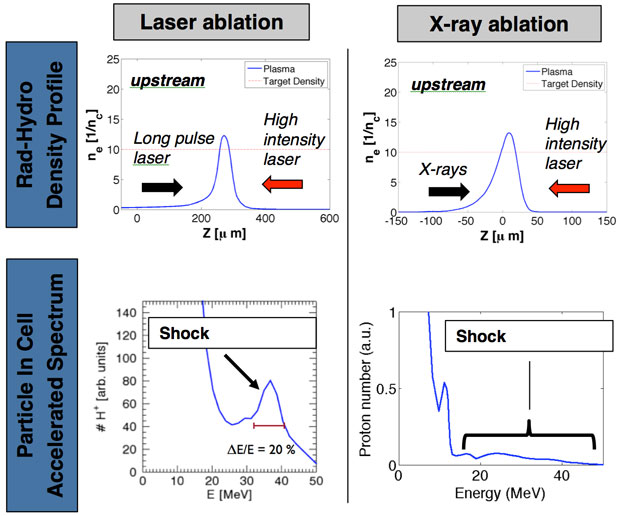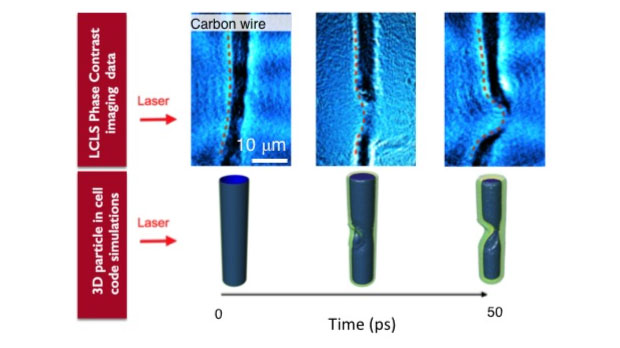Arthur Pak (15-LW-095)
Abstract
Our goal was to produce and diagnose laser-driven electromagnetic and electrostatic collisionless shock waves, which are pervasive in astrophysical environments and are known to be efficient cosmic-ray accelerators. However, the microphysics of shock formation and particle acceleration is not yet well understood. To study the origin of the high-energy cosmic ray spectrum, we attempted to produce an electromagnetic shock wave. We also studied electrostatic shock waves, which are of interest because they can produce a narrow-energy-spread ion beam that is ideal for applications requiring the precise deposition of energy. We first obtained beam time at the Linear Coherent Light Source at the SLAC National Accelerator Laboratory in Menlo Park, California, to study electromagnetic shock waves. However, because of a damaged laser, the requisite flow velocity to initiate the shock wave could not be produced. However, promising results were obtained from our experimental study of electrostatic shock waves. We have shown, for the first time, evidence of the strong accelerating field from a relativistic electrostatic collisionless shock wave. We have also observed accelerated ions that exhibit narrow-energy spectral peaks. To achieve this, we developed new methods to create near-critical-density targets. Proton beams with particle numbers up to 1010 at 30 MeV were obtained. However, beams with energies of about 100 MeV, which were predicted by initial calculations, were not produced. Recent modeling suggests that species separation of plasma ions and the plasma-density profile limit the peak energy and increase the energy spread of accelerated ions, as compared to the idealized profiles and a single-species plasma initially modeled.
Background and Research Objectives
As ejecta from energetic astrophysical events stream through interstellar media, plasma instabilities generate strong electromagnetic fields that scatter the particles of the incoming flow, slowing it down and generating a collisionless shock (i.e., the shock is not mediated by Coulomb collisions but by collective plasma processes). These shock structures are believed to be the dominant source of energetic cosmic rays in the universe.1,2 However, the process through which shocks are formed and accelerate particles is still under debate. Depending on the nature of the plasma instabilities that lead to shock formation, shocks can be classified as electromagnetic or electrostatic, and have correspondingly different field structures and particle acceleration mechanisms. The advent of advanced high-intensity optical and x-ray lasers, as well as particle probes, now offer the possibility of creating and diagnosing these collisionless shock waves in the laboratory.
In near-critical-density plasmas, the laser interacts with most of the plasma volume and electron heating is dominant. For intense laser pulses, the ponderomotive force of the laser can compress and heat a localized region to high pressure. As this high-pressure region rapidly expands into the lower-density upstream plasma, an electrostatic shock can be formed.3,4 The sharp electric field associated with the shock front can reflect background ions as the shock moves through the plasma, generating an ion beam with twice the shock velocity (reflection by a “moving wall”).4,5
One of our goals with this project was to produce proton beams with narrow energy spreads and peak energies of approximately 100 MeV, using petawatt-class lasers. A major challenge was creating suitable near-critical-density targets for the optical wavelength of the petawatt lasers. We planned to visualize the accelerating fields of the shock wave and relate the velocity to the observed accelerated spectrum. This is extremely challenging and required the use of a charged-particle probe with high spatial and temporal resolution. Detailed Particle-in-Cell simulations show that under the right conditions, petawatt-class lasers can extend the energy of proton beams to greater than 100 MeV/amu, less than 10% energy spread, and approximately 1012 ions per bunch,3,4 opening exciting new applications. Examining calculations, we found the acceleration of ions with these properties is quite sensitive to the prescribed plasma-density profile. These profiles are quite challenging to achieve in reality. Despite these challenges, experimental results have been obtained, indicating a strong localized electric field consistent with the formation of an electrostatic shock wave, as well as beams of protons with narrow energy spreads (~25% ΔE/E). The peak energy of the narrow-energy-spread portion of these beams did not exceed about 20 MeV. The beam number was estimated to be approximately 1010 ions per bunch, which is 1,000 times greater than previous work, but still 100 times lower than idealized calculations.
In overcritical-density plasmas, the laser-radiation pressure dominates, accelerating fast plasma flows that are unstable to electromagnetic instabilities (namely the Weibel instability6) and generating strong micrometer-scale filamentary magnetic fields in the dense background plasma. These fields slow down the flow and generate an electromagnetic shock.1 The timescale of shock formation is strongly dependent on the relative velocity of counter-streaming plasma flows. One of our primary objectives was to use the Linac Coherent Light Source to resolve the filamentary structure associated with the Weibel instability and shock formation.
Scientific Approach and Accomplishments
Our technical approach was to start with detailed Particle-in-Cell code modeling to understand the conditions whereby the available lasers could drive these collisionless shocks. Once this was determined, an appropriate target had to be created. Common to both studies was the creation of a plasma target with a peak plasma density that was above the critical density of the laser. For the electromagnetic study, a cryogenic liquid hydrogen jet target, developed by our Stanford collaborators, was employed to utilize the high repetition rate of the facility. This type of target is ideal because it keeps the peak density above the critical density, at approximately 40 nc, but is still a factor of 100 times less dense than conventional solid targets. This low density is critical for driving the fast flows necessary to initiate the Weibel instability.
For the electrostatic shock study, a target with a variable peak density of 5 to 20 nc and a plasma scale length of about 10 to 20 µm was required. This type of target did not exist. Using radiation-hydrodynamic calculations, we first modeled how optical laser or x-ray ablation of thin (~1-µm thick) initially solid-density hydrocarbon foil could be used to produce an appropriate profile.
During our experiment at the Linac Coherent Light Source, damage to the laser limited the intensity of the laser, reducing the obtainable flow velocity. With the available laser intensity, we were unable to drive a flow fast enough to initiate the Weibel instability. However, we successfully resolved the dynamics of laser hole boring and the late-time expansion of the plasma phase contrast on surrogate carbon targets. This is shown in Figure 1, where the top row of images details the deformation that occurs as the laser pulse drives a flow and bores through an initially 10-µm-thick carbon-wire target. As shown on the bottom of row of Figure 1, detailed three-dimensional Particle-in-Cell code calculations are being conducted to model the observed deformation.
The generation of electrostatic shocks and subsequent ion acceleration were studied experimentally using Livermore's laser and the OMEGA Extended Performance (EP) laser at the Laboratory for Laser Energetics at the University of Rochester in New York. In FY15 and 16, we performed 2, 6-week (~40 shots) experiments at Titan. To gain access to the OMEGA EP laser, we have started a new collaboration with the University of Rochester and successfully pursued time through the Laboratory's basic science proposal system.
At Titan, a long-pulse optical laser can be used to directly ablate and tailor the density profile, while at OMEGA EP, an x-ray drive is used. After the plasma density profile has been formed, a second picosecond-long laser pulse with a high intensity of about 1020 W/cm2 was used to irradiate the target and drive the electrostatic shock wave. Figure 2 details the differences in the predicted laser and x-ray produced density profiles and the resulting ion acceleration that occurs.
As seen in Figure 2, the short ablation-front scale length of the optical laser results in a profile that has shorter plasma-scale lengths, while the x-ray drive volumetrically heats the entire foil, leading to a longer rear and front scale length. In the laser ablation case, the shock propagates at a relatively uniform velocity in the upstream plasma, leading to the reflection of a narrow-energy-spread peak at about 35 MeV. For similar conditions of the high-intensity laser, in the x-ray ablation case, the shock velocity is not constant because of the longer plasma scale length. Calculations show that the shock reflects upstream ions into a broad, approximately 100% energy-spread plateau.
Furthermore, tracking the hydrogen and carbon ion species in the Particle-in-Cell code calculations, the mass ratio difference leads to the separation of the two ion species at the shock front. This reduces the magnitude of the field associated with the shock wave, leading to lower reflected ion energies. The non-idealized plasma-density profiles, and the phase separation of multiple ion species are the two effects that we believe limited the energy gain of protons in these experiments.
Figure 3 shows recently obtained proton spectra from our FY16 experimental campaign at the Titan laser facility. Figure 3(a) shows the proton spectrum for an experiment where a long-pulse laser was first used to ablate and tailor the plasma density profile of an initially 0.5-µm-thick methylene target. Here, a narrow-energy-spread beam with ΔE/E of about 25% at a peak energy of approximately 13 MeV was observed. In contrast, Figure 3(b) shows the continuous spectrum that was produced without using the long-pulse laser to tailor the density profile. This spectrum exhibits the expected exponential decay in particle number with energy associated with the target normal sheath acceleration mechanism.
To further pursue this work, we conducted experiments at OMEGA EP, and results from two experiments are shown in Figure 4. The first experiment was conducted using only the short-pulse back-lighter laser beam to accelerate protons via the target normal sheath acceleration mechanism. The beam profile, spectrum, and proton radiograph from this experiment are shown in Figure 4(c–e). Figure 4(f–h) shows these measurements from a second experiment. Here, before irradiating the target with the high-intensity short-pulse laser, a long-pulse laser was used to create an x-ray drive that tailored the plasma-density profile.
Here, a proton spectrum with a narrow-energy-spread feature followed by a high-energy plateau, in conjunction with a narrower beam divergence, was observed when the plasma-density profile was tailored. The proton radiography reveals an additional localized deflection of the proton probe, as shown in the dashed box Figure 1(h), which is also consistent with the formation of a collisionless electrostatic shock wave.
Impact on Mission
This project provided important insight into the physics of high-energy-density plasma in support of the Laboratory's core competency in high-energy-density science. In addition, it leads the way to development of a unique compact-ion source for research in fundamental science (plasma radiography), national security (material probing, active interrogation of nuclear materials, and injectors for conventional accelerators), and medical and biological applications (radiotherapy).
Conclusion
We will continue the research on electrostatic ion acceleration through the Laboratory's basic science program through FY17, and intend to publish two papers on this work. Preliminary results look promising, but also indicate that more work is needed to develop this into a practical ion source. Although this project fell short of demonstrating a Weibel-mediated collisionless shock, we have formed strong relationships with the larger community and will collaborate on experiments to demonstrate this form of collisionless shock in the near future. Our collaborators have submitted a proposal at the Linac Coherent Light Source to repeat the initial experiment to create a Weibel-mediated collisionless shock wave with a working laser.
References
- Bykov, A. M., and R. A. Treumann, “Fundamentals of collisionless shocks for astrophysical application.” Astrophys. Rev. 19 (2011).
- Ackermann, M., et al., “Detection of the characteristic pion-decay signature in supernova remnants.” Science 339, 807 (2013).
- Fiuza, F., et al., “Laser-driven shock acceleration of monoenergetic ion beams.” Phys. Rev. Lett. 109, 215001 (2012).
- Fiuza, F., et al., “Ion acceleration from laser-driven electrostatic shocks.” Phys. Plasmas 20, 056304 (2013).
- Silva, L. O., et al., “Proton shock acceleration in laser–plasma interactions.” Phys. Rev. Lett. 92, 015002 (2004).
- Weibel, E., “Spontaneously growing transverse waves in a plasma due to an anisotropic velocity distribution.” Phys. Rev. Lett. 2, 83 (1959).









